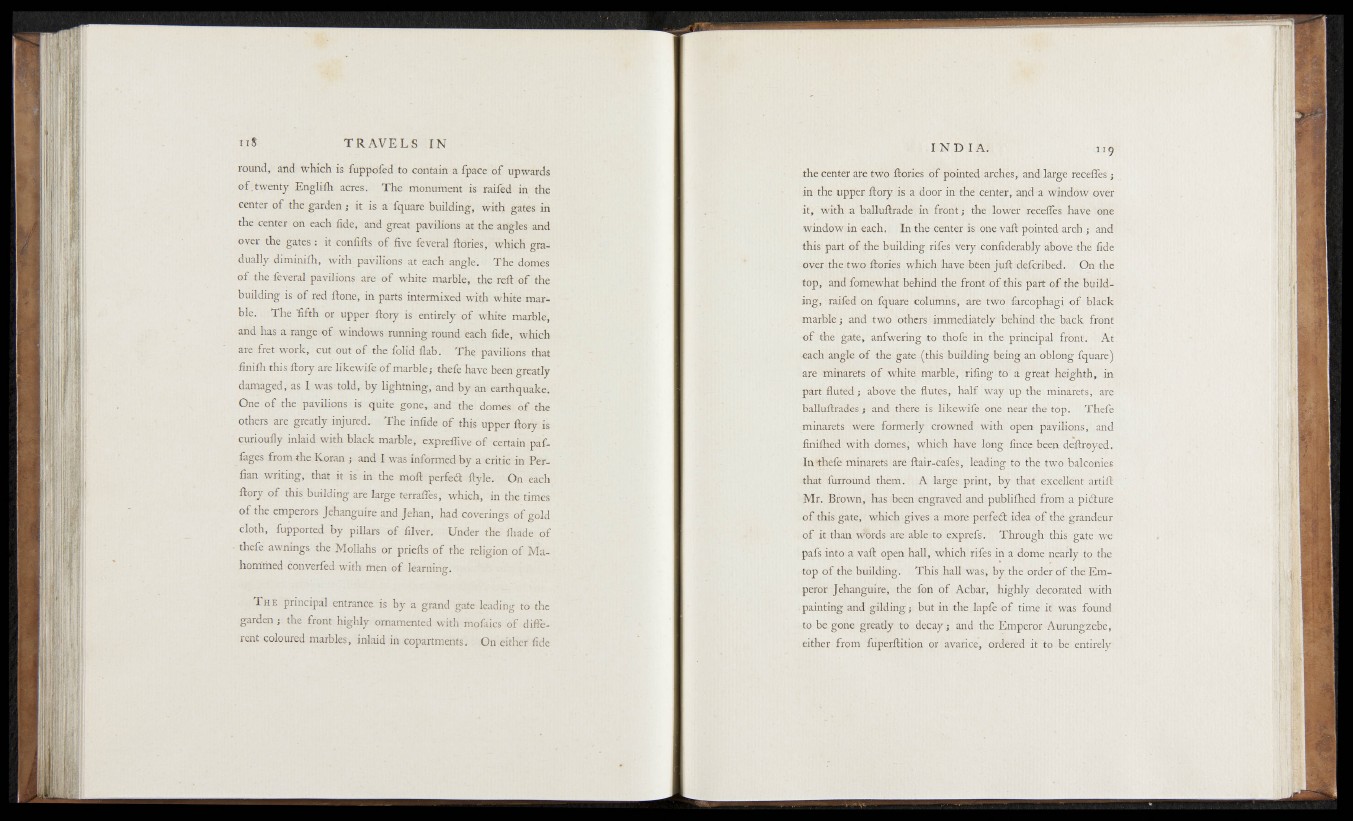
found, and which is fuppofed to contain a Ipace of upwards
of. twenty Englifh acres. The monument is raifed in the
center of the garden ; it is a fquaxc building, with gates in
the center on each fide, and great pavdions at the angles and
over the gates : it confifts o f five feveral ftories, which gradually
diminifli, with pavilions at each angle. The domes
of the lèverai pavilions are of white marble, the reft of the
building is- of red ftone, in parts intermixed with white mar-
ble. : The fifth or upper ftoiy is entirely of white marble,
and has a range of windows running round each fide, winch
are fret work, cut out o f the folid flab. The pavilions that
finifli this Rory areJikewife of marble; thefe have been greatly
damaged, as I was told, by lightning, and by an earthquake.
One of the pavilions is quite gone, and: the domes of the
others are greatly injured. The infide of this upper ftory is
curioufly inlaid with black marble, exprefiiye of certain paf-
fages from the Koran ; and I was informed by a critic in Per-
fian writing, that it is' in the molt perfeft ftyle. On each
ftory of this building are large terraflfes, which, in the times
of the emperors Jehainguire and Jehan, had coverings of gold
cloth, fupported by pillars o f filver. Under the lhade of
thefe awnings the Mollahs or priefts of the religion of Ma-
homihed converfed with men of learning.
T he principal entrance, is by a grand gate' leading to the
garden ; the front highly ornamented with mofaics of différait
coloured marbles, inlaid in copartments. On either fide
the center are two ftories of pointed arches, and large rfeeeflfes'j
in the upper ftoiy is a .door in the center, and a window over
it, with .a baftuftrade in fcont ; the lowrer receflès have one
•window in each. In the:center is one -vaft-pointed arch ; and
this part of the building rdfes very .cohfiderabiy above ithe fide
over the two ftories which have been juftrdefcribed. On the
top, and fomewhat behind the front of this part of the building,
raifed on fquare columns, are tewri;ffarbophagi o f blàbk
marble ; and two others immediately behind the back front
-of A e g^te, anfwering to thofe’iri the principal front. At
-each angle of the gate .(this building being an-oblong fquare)
are minarets of white marble, rifing'to'a. greartteighth, sfe;
part fluted; aboye-:the flutes, half way up the minaretsi'^are
balluftrades; and there is likewife one near the'top. Thefe
minarets were formerly crowned with open pavilions, and
finished with domes; which have long fince been deftreyed.
Inlthefe minarets are flair-cafes, leading to the two balconies
that furround them. A large print, by that excellent artift
Mr. Brown, has -been engraved and publifhed from a piâure
of this gate, which gives a- more perfed; idea of thé grandeur
of it than vrords are aMe;to exprefs. Through- this"gate we
pafs into a vaft ©pen hall, which rifes in a dome nearly to the
top of the building. This hall was; h y the order of the'Em-
peror Jehanguire, the fon of -Acbar, highly decorated with
painting and gilding' ; but in the lapfe o f time if was found,
to be gone greatly to decay ; and the Emperor -Aurungzebe,
either from fiiperftition or avarice, ordered it to be entirely